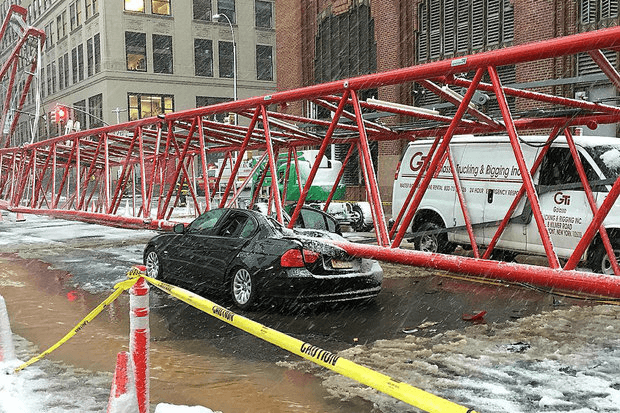Crane Accidents

In recent years New York has seen an increase in high-rise construction utilizing cranes. It is difficult to view the New York skyline without noting the presence of construction cranes. Construction crane accidents can cause injuries to workers and passersby alike. Unfortunately, recent years have also seen a rise in the numbers of crane accidents, with 433 accidents injuring 471 workers and pedestrians in 2015 alone, almost twice the number of crane accidents from the year 2014 according to New York City Department of Buildings records.
When cranes collapse the results are often catastrophic given the height, size and weight of the crane structures (cab, boom, tower) and their loads. Crane failures commonly cause fatal and serious life threatening injuries. Crane accident can occur in a wide variety of ways including, crane buckling due to overweight loads, failure due to wind and weather conditions, improper assembly, failure to utilize proper safety procedures, improper operator training, operator error, poor maintenance, mechanical fatigue and wear, contact with power lines, and the failure to perform regular or proper safety inspections.
The Occupational Safety and Health Administration (OSHA) has established guidelines to minimize the potential for crane accident:
1. Before using a crane, an inspector should check the machine for any mechanical problem that may result in accidents.
2. The crane machine must undergo a more comprehensive inspection on a regular basis to determine if there is a crack, faulty wiring, worn-out ropes, and any damaged part that could lead to accidents.
3. If there is any damaged part which must be repaired or modified, this should be done by a qualified person.
4. Place the crane on a stable and flat ground which must be at least 10-feet away from electrical cables.
5. Make sure the crane is not carrying a load which is more than its capacity. Under US standards for mobile cranes, the load should not be more than 7 percent of the tipping weight.
6. Install fences around the construction site to prevent outsiders from going near the crane.
7. Make sure the crane’s safety devices such as the level operator are working properly.
8. While operating a crane, there should be a qualified “signal” person who will assist the operator in maneuvering loads.
9. There should be fall protection equipment for workers who are standing more than 6-feet above the ground.
10. The loads should be set by a qualified “rigger” to make sure that these will not come loose and strike a worker.
11. The foundation for a tower crane and other structural supports for this machine should be designed by its manufacturer or a professional engineer.
12. Crane operators should consider the wind as the most important safety concerns. In a recent study conducted by OSHA, high-speed wind conditions are a leading cause of crane accidents in the US.
13. Due to stability concerns, cranes mounted on ships and offshore platforms should be used more carefully.
If you or a loved one has been injured in a crane-related accident, it is important to hire a lawyer or law firm that has the experience and skill to properly investigate and pursue a claim for compensation.
Contact Certain & Zilberg today to set-up a free no-obligation appointment to have your questions answered about your defective crane claim.


